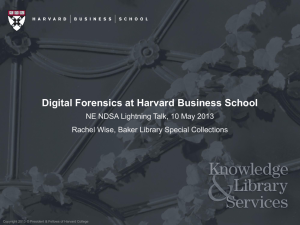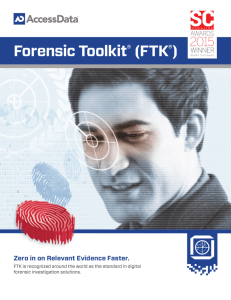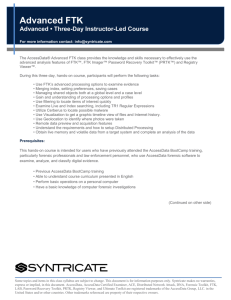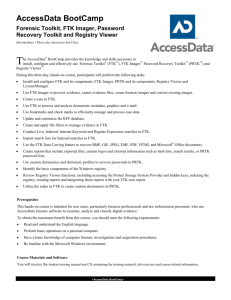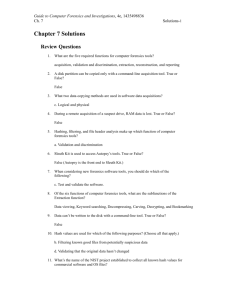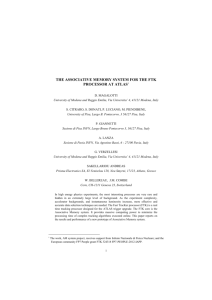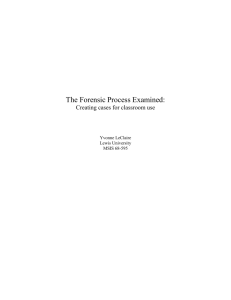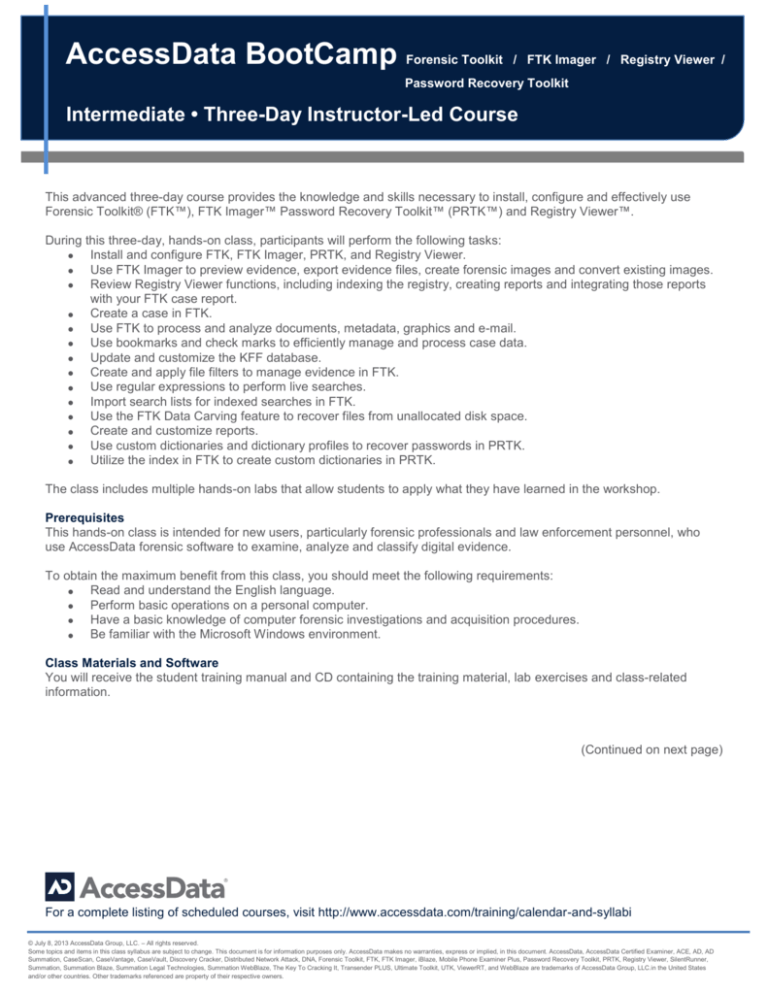
AccessData BootCamp Forensic Toolkit
/ FTK Imager / Registry Viewer /
Password Recovery Toolkit
Intermediate • Three-Day Instructor-Led Course
This advanced three-day course provides the knowledge and skills necessary to install, configure and effectively use
Forensic Toolkit® (FTK™), FTK Imager™ Password Recovery Toolkit™ (PRTK™) and Registry Viewer™.
During this three-day, hands-on class, participants will perform the following tasks:
Install and configure FTK, FTK Imager, PRTK, and Registry Viewer.
Use FTK Imager to preview evidence, export evidence files, create forensic images and convert existing images.
Review Registry Viewer functions, including indexing the registry, creating reports and integrating those reports
with your FTK case report.
Create a case in FTK.
Use FTK to process and analyze documents, metadata, graphics and e-mail.
Use bookmarks and check marks to efficiently manage and process case data.
Update and customize the KFF database.
Create and apply file filters to manage evidence in FTK.
Use regular expressions to perform live searches.
Import search lists for indexed searches in FTK.
Use the FTK Data Carving feature to recover files from unallocated disk space.
Create and customize reports.
Use custom dictionaries and dictionary profiles to recover passwords in PRTK.
Utilize the index in FTK to create custom dictionaries in PRTK.
The class includes multiple hands-on labs that allow students to apply what they have learned in the workshop.
Prerequisites
This hands-on class is intended for new users, particularly forensic professionals and law enforcement personnel, who
use AccessData forensic software to examine, analyze and classify digital evidence.
To obtain the maximum benefit from this class, you should meet the following requirements:
Read and understand the English language.
Perform basic operations on a personal computer.
Have a basic knowledge of computer forensic investigations and acquisition procedures.
Be familiar with the Microsoft Windows environment.
Class Materials and Software
You will receive the student training manual and CD containing the training material, lab exercises and class-related
information.
(Continued on next page)
For a complete listing of scheduled courses, visit http://www.accessdata.com/training/calendar-and-syllabi
© July 8, 2013 AccessData Group, LLC. – All rights reserved.
Some topics and items in this class syllabus are subject to change. This document is for information purposes only. AccessData makes no warranties, express or implied, in this document. AccessData, AccessData Certified Examiner, ACE, AD, AD
Summation, CaseScan, CaseVantage, CaseVault, Discovery Cracker, Distributed Network Attack, DNA, Forensic Toolkit, FTK, FTK Imager, iBlaze, Mobile Phone Examiner Plus, Password Recovery Toolkit, PRTK, Registry Viewer, SilentRunner,
Summation, Summation Blaze, Summation Legal Technologies, Summation WebBlaze, The Key To Cracking It, Transender PLUS, Ultimate Toolkit, UTK, ViewerRT, and WebBlaze are trademarks of AccessData Group, LLC.in the United States
and/or other countries. Other trademarks referenced are property of their respective owners.
AccessData BootCamp Forensic Toolkit
/ FTK Imager / Registry Viewer /
Password Recovery Toolkit
Intermediate • Three-Day Instructor-Led Course
(Continued)
Module 1: Introduction
Module 3: Working with Registry Viewer
Topics
Identify the FTK components.
List the FTK and PRTK system requirements.
Describe how to receive upgrades and support for
AccessData tools.
Install required applications and drivers.
Objectives
Lab
Participants will install the UTK components—FTK,
KFF Library, FTK Imager, Registry Viewer, and PRTK.
Module 2: Working with FTK Imager
Objectives
Describe standard data storage devices.
Identify some common software and hardware
acquisition tools.
List some common forensic image formats.
Use FTK Imager to perform the following functions:
o Preview evidence
o Export data files
o Create a hash to benchmark your case evidence
o Acquire an image of evidence data
o Convert existing images to other formats
Use dockable windows in FTK Imager.
Navigate evidence items.
Use the properties and interpreters windows.
Validate forensic images.
Create Custom Content Images.
Mount images.
Capture active RAM.
Labs
During the practical, participants acquire an image of a
thumb drive, then explore the FTK Imager features
and functions discussed in the module, including
converting an image to a different image format,
creating a Custom Content Image, and mounting an
image.
Describe which files comprise the Windows
Registry.
Discuss the elements of the Registry Viewer
interface.
Identify the key features of the Registry Viewer.
Outline the use of FTK with other tools.
Create a basic report from FTK.
Seamlessly launch Registry Viewer from an FTK
case.
Determine a user’s time zone setting.
Determine a user’s SID.
Lab
During the practical, participants use Registry Viewer
to recover information from a sample image.
Participants will then generate registry reports for
individual registry files.
Module 4: Working with FTK—Part 1
Objectives
Effectively use the Case Manager.
Create and administer users.
Back up, delete, and restore cases.
Identify the evidence processing options.
Create a case.
Identify the basic FTK interface components,
including the menu and toolbar options as well as
the program tabs.
Obtain basic analysis data.
Lab
During the practical, participants go through the introductory
steps of processing a case, including creating a case,
adding evidence to the case, and processing case evidence.
Students will also perform basic system functions such as
creating user accounts and defining different levels of
permissions to a case, managing shared objects, and
customizing the FTK interface.
For a complete listing of scheduled courses, visit http://www.accessdata.com/training/calendar-and-syllabi
©July 8, 2013 AccessData Group, LLC. – All rights reserved.
Some topics and items in this class syllabus are subject to change. This document is for information purposes only. AccessData makes no warranties, express or implied, in this document. AccessData, AccessData Certified Examiner, ACE, AD,
AD Summation, CaseScan, CaseVantage, CaseVault, Discovery Cracker, Distributed Network Attack, DNA, Forensic Toolkit, FTK, FTK Imager, iBlaze, Mobile Phone Examiner Plus, Password Recovery Toolkit, PRTK, Registry Viewer,
SilentRunner, Summation, Summation Blaze, Summation Legal Technologies, Summation WebBlaze, The Key To Cracking It, Transender PLUS, Ultimate Toolkit, UTK, ViewerRT, and WebBlaze are trademarks of AccessData Group, LLC.in the
United States and/or other countries. Other trademarks referenced are property of their respective owners.
AccessData BootCamp Forensic Toolkit
/ FTK Imager / Registry Viewer /
Password Recovery Toolkit
Intermediate • Three-Day Instructor-Led Course
(Continued)
Module 5: Working with FTK—Part 2
Objectives
Change time zone display.
Create and manage bookmarks.
View compound files.
Export files and folders.
Create custom column settings to manage the
information that appears in the FTK file list.
Use the Copy Special and Export File List Info
features.
Create and manage bookmarks.
Perform additional analysis, such as full text
indexing, after evidence has been added to the
case.
Perform automatic and manual data carving
functions.
Lab
The labs in this module guide participants through
more advanced functions in processing case evidence.
During the practical, participants will bookmark
evidence, view metadata and compound files, examine
registry files, recover deleted files from the Recycle
Bin, export case files and folders, create custom
column settings, decrypt files, and use the data
carving feature to recover evidence items from file
slack and unallocated space.
Lab
During the practical, participants explore FTK features to
view, sort, and export email and graphic artifacts from the
case. Students will also create custom columns for graphics
and email, export email and graphics files, and create a
hash list.
Module 7: Narrowing Your Focus
Objectives
Narrow evidence items using the Known File Filter,
checked items, and filtered/ignored items.
Perform an indexed search.
Perform a live search.
Import search terms from text files.
Perform a regular expression search.
Lab
During the practical, participants learn how to
effectively sort through case evidence to locate items
of interest. Students will use the KFF database to
ignore or flag known files, perform keyword searches,
use dtSearch options to customize a search, and use
regular expressions to search case evidence for
pattern data such as credit card numbers or IP
addresses.
Module 8: Filtering the Case
Module 6: Processing the Case
Objectives
Identify the elements of a graphics case.
Navigate the FTK Graphics tab.
Export graphics files and hash sets.
Tag graphics files using the Bookmarks feature.
Identify the elements of an email case.
Identify supported email types.
Navigate the FTK Email tab.
Sort email.
Find a word or phrase in an email message or
attachment.
Export email items.
Objectives
Explain basic concepts of rule-based filtering in FTK.
Design a basic filter and use it to filter data.
Manage shared filters.
Discuss the use of compound filters.
Explain the difference between global and tab filters.
Import and export filters.
Lab
During the labs, participants create filters to locate
specific items of interest. Students will further refine
filter results using compound filters. Finally, students
will have a change to import and export filters so they
can share filters with co-workers and colleagues.
For a complete listing of scheduled courses, visit http://www.accessdata.com/training/calendar-and-syllabi
©July 8, 2013 AccessData Group, LLC. – All rights reserved.
Some topics and items in this class syllabus are subject to change. This document is for information purposes only. AccessData makes no warranties, express or implied, in this document. AccessData, AccessData Certified Examiner, ACE, AD,
AD Summation, CaseScan, CaseVantage, CaseVault, Discovery Cracker, Distributed Network Attack, DNA, Forensic Toolkit, FTK, FTK Imager, iBlaze, Mobile Phone Examiner Plus, Password Recovery Toolkit, PRTK, Registry Viewer,
SilentRunner, Summation, Summation Blaze, Summation Legal Technologies, Summation WebBlaze, The Key To Cracking It, Transender PLUS, Ultimate Toolkit, UTK, ViewerRT, and WebBlaze are trademarks of AccessData Group, LLC.in the
United States and/or other countries. Other trademarks referenced are property of their respective owners.
AccessData BootCamp Forensic Toolkit
/ FTK Imager / Registry Viewer /
Password Recovery Toolkit
Intermediate • Three-Day Instructor-Led Course
(Continued)
Module 9: Case Reporting
Module 10: Working with PRTK
Objectives
Define a report.
o Modify the case information
o Include a list of bookmarked files
o Export bookmarked files with the report
o Include thumbnails of bookmarked graphics
o Manage the appearance of the Bookmark section
o Include thumbnails of case graphics
o Link thumbnails to full-sized graphics in the report
directory
o Export and link video files
o Export rendered videos and thumbnails
o Include a list of directories, subdirectories, files,
and file types
o Include a list of case files and file properties in the
report
o Export case files associated with specific file
categories
o Append a registry report to the case report
Generate reports in the following formats:
o PDF
o HTML
o RTF
o WML
o XML
o DOCX
o ODT
Generate reports in other languages.
Objectives
Navigate within the PRTK interface.
Identify the available password recovery modules
and their associated attack types.
Import user-defined dictionaries and FTK word lists
to use in a password recovery attack.
Create biographical dictionaries.
Set up profiles.
Explain what a PRTK profile is and how it is used.
Recount the AccessData Methodology.
Lab
During the labs, participants will use PRTK to recover
passwords from data files. Students will also apply the
AccessData Methodology to decrypt files in a sample
image. This process will require students to export the
FTK case index and Registry Viewer’s registry index to
create a custom dictionary, create a biographical
dictionary and custom profiles, then re-apply intel
gathered from decrypted files to attack other encrypted
files.
Lab
During the practical, participants create multiple
reports from a single case to explore all options
available from the report wizard. They build from a
very basic report to a detailed report that contains
customized report items.
For a complete listing of scheduled courses, visit http://www.accessdata.com/training/calendar-and-syllabi
©July 8, 2013 AccessData Group, LLC. – All rights reserved.
Some topics and items in this class syllabus are subject to change. This document is for information purposes only. AccessData makes no warranties, express or implied, in this document. AccessData, AccessData Certified Examiner, ACE, AD,
AD Summation, CaseScan, CaseVantage, CaseVault, Discovery Cracker, Distributed Network Attack, DNA, Forensic Toolkit, FTK, FTK Imager, iBlaze, Mobile Phone Examiner Plus, Password Recovery Toolkit, PRTK, Registry Viewer,
SilentRunner, Summation, Summation Blaze, Summation Legal Technologies, Summation WebBlaze, The Key To Cracking It, Transender PLUS, Ultimate Toolkit, UTK, ViewerRT, and WebBlaze are trademarks of AccessData Group, LLC.in the
United States and/or other countries. Other trademarks referenced are property of their respective owners.

